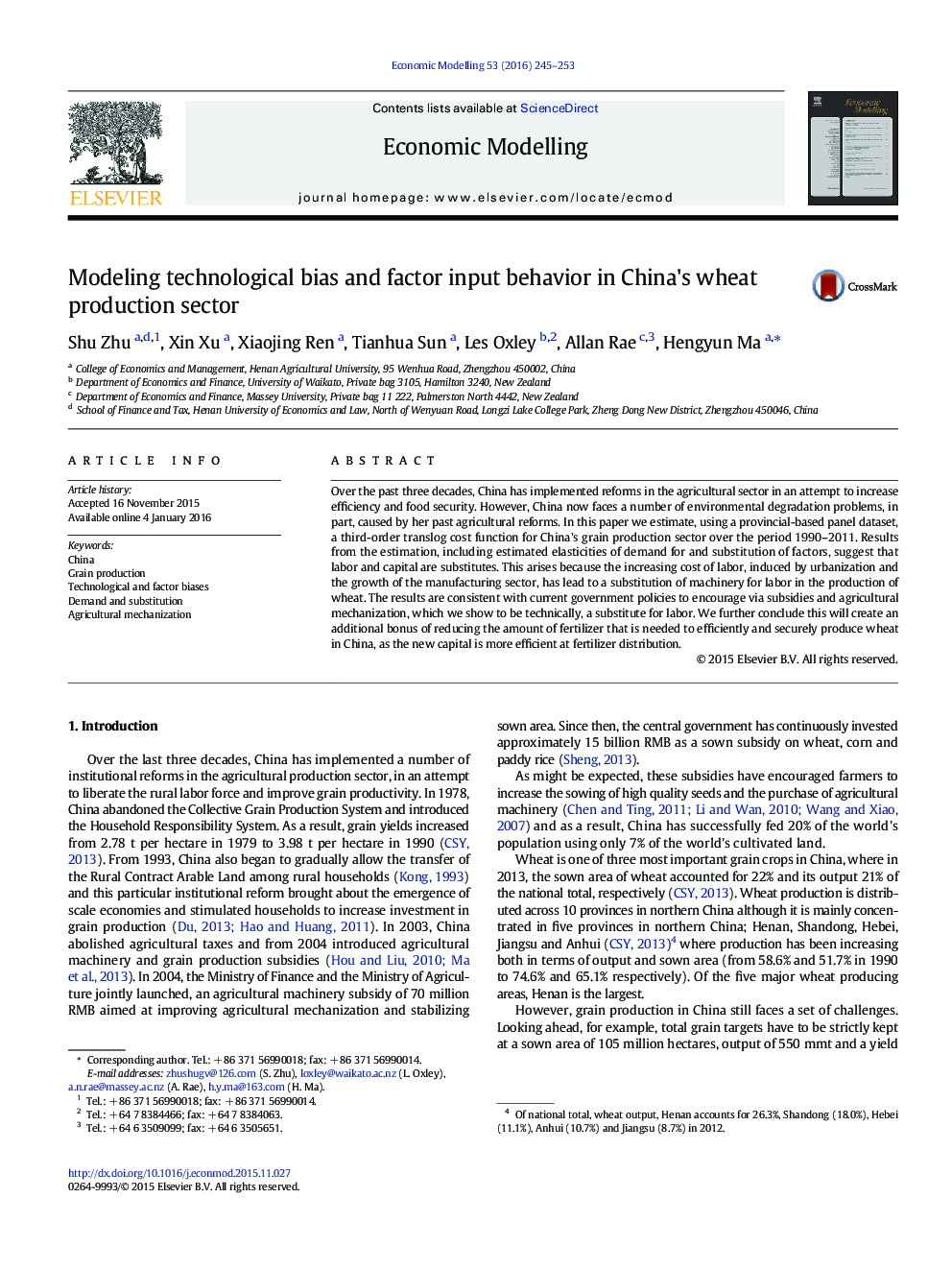| کد مقاله | کد نشریه | سال انتشار | مقاله انگلیسی | نسخه تمام متن |
|---|---|---|---|---|
| 5053608 | 1476516 | 2016 | 9 صفحه PDF | دانلود رایگان |
عنوان انگلیسی مقاله ISI
Modeling technological bias and factor input behavior in China's wheat production sector
ترجمه فارسی عنوان
مدل سازی تعادل فن آوری و رفتار ورودی عامل در بخش تولید گندم چین
دانلود مقاله + سفارش ترجمه
دانلود مقاله ISI انگلیسی
رایگان برای ایرانیان
ترجمه چکیده
در طی سه دهه گذشته، چین اصلاحات در بخش کشاورزی را در تلاش برای افزایش بهره وری و امنیت غذایی انجام داده است. با این حال، چین در حال حاضر با تعدادی از مشکلات تخریب زیست محیطی مواجه است، که بخشی از آن به دلیل اصلاحات کشاورزی گذشته است. در این مقاله، با استفاده از یک مجموعه داده پانلی مبتنی بر استان، یک تابع هزینه ترانسفورماتور برای بخش تولیدی در چین در دوره 1990-2011، تخمین زده می شود. نتایج برآورد، از جمله برآورد تقاضا و جایگزینی عوامل، نشان می دهد که کار و سرمایه جایگزین هستند. این به این دلیل بوجود می آید که افزایش هزینه های کار، ناشی از شهرنشینی و رشد بخش تولید، منجر به جایگزینی ماشین آلات برای کار در تولید گندم شده است. نتایج مطابق با سیاست های فعلی دولت برای تشویق از طریق یارانه ها و مکانیزاسیون کشاورزی است، که ما نشان می دهیم که از لحاظ فنی، جایگزینی برای کار است. ما بیشتر نتیجه می کنیم این یک پاداش اضافی برای کاهش میزان کود لازم است که به طور موثر و ایمن تولید گندم در چین ایجاد می شود، زیرا سرمایه جدید در توزیع کود مؤثر است.
موضوعات مرتبط
علوم انسانی و اجتماعی
اقتصاد، اقتصادسنجی و امور مالی
اقتصاد و اقتصادسنجی
چکیده انگلیسی
Over the past three decades, China has implemented reforms in the agricultural sector in an attempt to increase efficiency and food security. However, China now faces a number of environmental degradation problems, in part, caused by her past agricultural reforms. In this paper we estimate, using a provincial-based panel dataset, a third-order translog cost function for China's grain production sector over the period 1990-2011. Results from the estimation, including estimated elasticities of demand for and substitution of factors, suggest that labor and capital are substitutes. This arises because the increasing cost of labor, induced by urbanization and the growth of the manufacturing sector, has lead to a substitution of machinery for labor in the production of wheat. The results are consistent with current government policies to encourage via subsidies and agricultural mechanization, which we show to be technically, a substitute for labor. We further conclude this will create an additional bonus of reducing the amount of fertilizer that is needed to efficiently and securely produce wheat in China, as the new capital is more efficient at fertilizer distribution.
ناشر
Database: Elsevier - ScienceDirect (ساینس دایرکت)
Journal: Economic Modelling - Volume 53, February 2016, Pages 245-253
Journal: Economic Modelling - Volume 53, February 2016, Pages 245-253
نویسندگان
Shu Zhu, Xin Xu, Xiaojing Ren, Tianhua Sun, Les Oxley, Allan Rae, Hengyun Ma,
